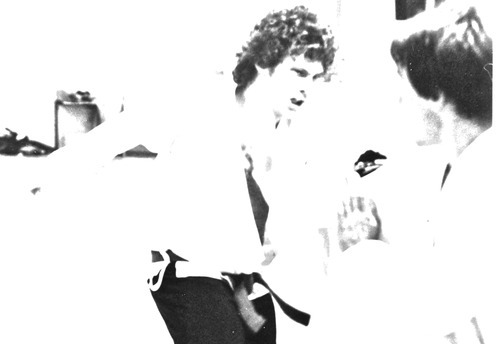CHRONICLES OF THE DOKA
#22 in a continuing series— 84 days in the teaching life of anAmerican sensei in 1999

I gather the class to clarify why
everyone is here and what the role of a sensei entails.
“Please
do not implore me to change my teaching to meet needs that don’t serve a
training goal you may not fully understand as beginners. If you want to learn
something I don’t teach you will have to go elsewhere to get those lessons. Karate-Do
offers a very different destination than karate jitsu. The Do offers clarity to your own Life path. We can have fun
but, more importantly, we want to cover real ground. Following the ‘Do’ should
have some measure of spontaneity but more so it will require self-discipline,
consistency and commitment.
I have a problem brewing with a brown
belt named Steve. Tommy, his peer, has nicknamed him, ‘Cyborg.’
The name stuck. Steve’s former training partner, Tom S, a stocky,
tree trunk of a man, described Steve as “ruthless.” A former
black belt also remarked that Steve was the smartest man he he’d ever met!
Steve is forty-seven years old. By most
statistics he started late in karate. He joined my class at thirty-seven, following in the wake of his two sons. He beat the flexibility odds for
his age by increasing his range of motion to an exceptional degree. He has
electrifying kata applications. Grown men in the class wince, even retreat, in
the face of his stunning power when partnered with him.
His
two sons, Mike and Tommy hold brown belts. The boys began study with me at the
age of five. They are now strapping teens. We videotaped Steve’s oldest son,
Mike several months ago prior to leaving for his first year at Yale. Mike demonstrated some the best black belt kumite
ever. A few weeks ago Tommy, his younger brother, struck another teen, Mike
Goodwin, so hard with a reverse body punch body that Mike has still not been
able to return to class five weeks later!
Like Steve, his two sons possess exceptional power and intelligence.
But Steve was mentally out of it during
Monday’s class. He looked liked he had aged several years. During that class he
left his sparring gloves at the dojo. Tonight, he shows up late wearing a
turquoise headband. For as long as I
have known him, he has worn a colored headband matching his next colored belt
promotion. He forgot his head band altogether on Monday. Tonight, it’s the
wrong color. Steve is off center. I sense spiritual unrest. Maybe the February
1st date I set for his Shodan test has shaken him up. But he’s not giving that thought up to anyone.
I am convinced however, that he will avoid his Black Belt test. He just doesn’t
look himself.
And Mitch may go off on a pressure point
tangent, which will only complicate his teaching.
If you think of a sensei as a gardener,
consider that weeds are constantly growing and need tending. Too many weeds in the dojo will stagnate, distort, stifle, over or under-accelerate
a student’s growth. Too much information too fast—too little information over
too great a time period—misinformation, ego blockages, physical blockages, all
these conditions can kill a student’s advance. Having difficulty with kicks and
punches aren’t the only things that stop students. There are a lot of psychic
pressure point blows, some even self-administered.
As
a philosophical observation, we are always walking across invisible bridges in
our lives, trying to reach multiple destinations, bridges to martial
advancement, bridges to career and relationship goals, etc.. The left side of
the bridge represents frustration. The right side—over-challenge. If you veer
too far to one side or another you will fall off the bridge. If you get too
frustrated, you will quit. It you get over-challenged, you will burn out prematurely.
The Buddhist influence in karate-do practice advises us to walk the middle way
in training.
It’s
also easy for an instructor to get caught up in the personal agendas of the men
and women in their classes. I could let my ego have full sway and simply force feed
people my lessons. But that would only be a temporary and resentful solution. I
don’t drag students forward by their hair. Learning martial arts should never
be student-versus-instructor, or students trying to overcome their sensei. It’s
about sharing in a process to bring more clarity, depth and dimension to our
advancement. Overbearing politics and personal egos can warp the growth of
students and remains one of the unfortunate realities in learning these arts today.
